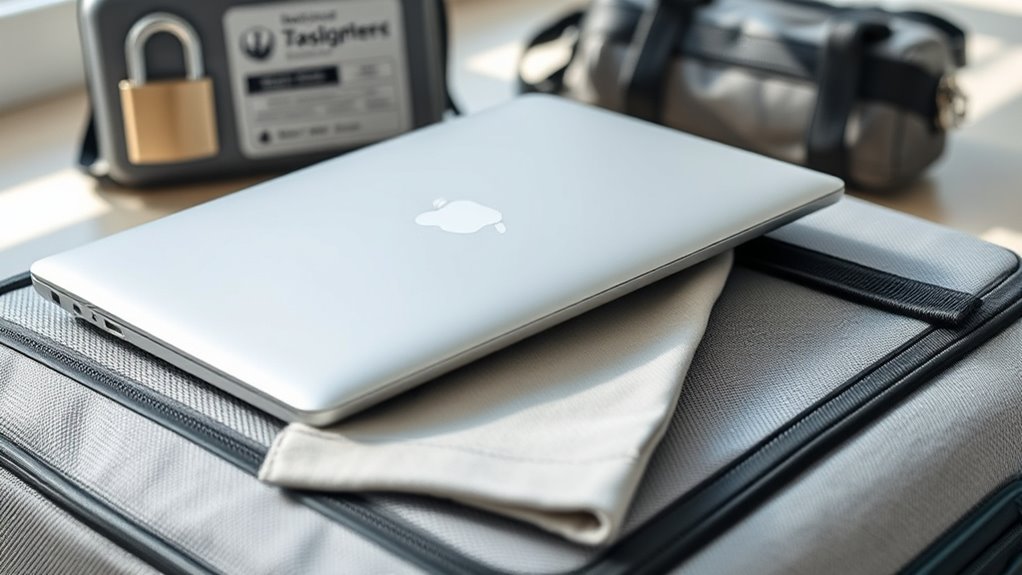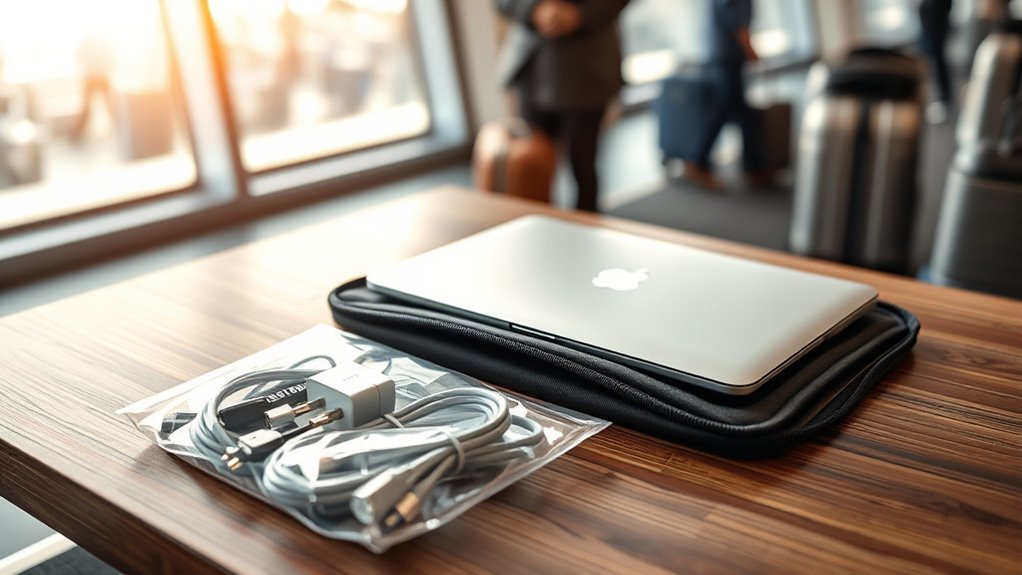When traveling with a laptop, choose a bag with padded compartments and multiple sections for organization to protect against shocks and scratches. Enable biometric security, use lockable pockets, and keep an eye on your device in crowded areas to prevent theft. Handle your laptop carefully with both hands and support it during movement. Regularly update software and use encryption to secure data. For more detailed tips on safeguarding your electronics abroad, keep exploring these essential security and care strategies.
Key Takeaways
- Use a padded, secure laptop bag with multiple compartments to protect devices from bumps and scratches.
- Enable biometric security features and lock compartments to prevent theft and unauthorized access during travel.
- Carry laptops in padded cases, open screens gently, and support the device to avoid physical damage.
- Keep software updated, use encryption, and avoid unsecured Wi-Fi to secure data and maintain privacy.
- Regularly clean and maintain your laptop’s hardware, including vents and batteries, for optimal performance and longevity.
Choosing the Right Laptop Bag and Packing Smart

When selecting a laptop bag, choosing one that offers both protection and convenience is vital. You want a bag that supports good laptop ergonomics, reducing strain during extended carries. Look for padded compartments that shield your device from bumps and shocks, especially during travel. Packing smart means organizing essentials efficiently, so your laptop is easily accessible yet secure. Consider bags with multiple compartments to keep accessories and documents separated, preventing damage or scratches. While travel insurance covers loss or theft, selecting a sturdy bag adds an extra layer of protection. Make certain the bag is comfortable to carry, with adjustable straps and ergonomic design features. This way, you stay comfortable and well-protected, making your travel experience smoother and less stressful. Additionally, choosing a shock-absorbing bag can further safeguard your laptop from impacts during transit. Incorporating appropriate storage solutions can help keep your gear organized and prevent accidental damage. Proper storage methods, such as using protective padding, are essential to maintain your electronics in good condition during travel. Using a durable material for the bag can enhance its longevity and resistance to wear and tear over time.
Protecting Your Device From Theft and Unauthorized Access

To prevent theft and unauthorized access, it’s essential to take proactive steps to secure your laptop both physically and digitally. Enable biometric security features like fingerprint scanners or facial recognition to restrict access. Keep your device in sight and use lockable compartments or anti-theft bags when in public. Additionally, install tracking devices or software that can locate your laptop if it gets lost or stolen. Regularly update your security settings and passwords to prevent unauthorized use. Avoid sharing your device’s location or login details. Be cautious in crowded or unfamiliar areas, and don’t leave your laptop unattended. Combining biometric security with tracking devices creates a layered defense, making it much harder for thieves to access or steal your device. Enhance Your Security Measures Additionally, staying informed about biodiversity threats related to digital security can help you better understand the risks and protective strategies for your devices. Developing a cybersecurity risk awareness can further strengthen your protection measures.
Handling Your Laptop to Prevent Physical Damage

Protecting your laptop from theft and unauthorized access is just one part of keeping it safe. Handling it properly helps prevent physical damage during travel. Always carry your laptop in a padded bag or case to avoid bumps and shocks. When opening or closing the lid, do so gently to protect the screen and hinges. Use screen protection, like a matte film or a cloth, to prevent scratches and smudges. Practice ergonomic handling by supporting your laptop with both hands when moving it, avoiding awkward grips that could cause drops. Avoid placing heavy objects on top of your device or stacking bags in a way that could crush it. Being mindful of how you handle your laptop reduces the risk of cracks, dents, and internal damage while on the go. Additionally, being aware of bike components and terrain can help you navigate and carry your gear more safely during outdoor activities. Proper handling also includes ensuring your device is clean and dry before packing it away to prevent moisture damage.
Securing Your Data and Keeping Privacy Safe

Securing your data and maintaining privacy while traveling requires proactive measures to prevent unauthorized access. Start by enabling strong privacy settings on your devices and apps, limiting who can see your information. Use encryption methods, such as full-disk encryption or encrypted messaging apps, to protect sensitive data both at rest and in transit. Regularly update your operating system and security software to patch vulnerabilities. Avoid connecting to unsecured Wi-Fi networks; instead, use a trusted VPN to encrypt your internet traffic. Be cautious when sharing information in public spaces, and always log out of accounts when you’re done. By taking these steps, you reduce the risk of data breaches and keep your personal information safe during your trip.
Maintenance Tips for Longevity and Performance

Regular maintenance is essential to keep your laptop running smoothly and extend its lifespan. Start with battery maintenance by avoiding constant full charges or deep discharges, which can shorten its life. Keep your battery healthy by unplugging once it reaches 80-90% and using power-saving settings when possible. Software updates are equally important; they fix bugs, improve security, and optimize performance. Regularly check for and install updates for your operating system and applications. Clean your device’s vents and keyboard to prevent overheating and dust buildup that can hinder performance. Additionally, uninstall unused programs and run disk cleanup tools to free up space. Ensuring proper air circulation around your device can also help prevent overheating, especially during long use sessions. Maintaining gadget care practices can further enhance your laptop’s longevity. Staying mindful of device management practices can further enhance your laptop’s longevity, and paying attention to hardware condition can help identify potential issues early. Being aware of personality test insights can also help you understand your device usage habits better, ensuring proper care. By staying on top of these maintenance tasks, you ensure your laptop remains reliable and efficient throughout your travels.
Frequently Asked Questions
How Can I Prevent My Laptop From Overheating During Travel?
To prevent your laptop from overheating during travel, guarantee proper laptop cooling and travel ventilation. Use a cooling pad if possible and avoid placing your device on soft surfaces like beds or couches that block airflow. Keep vents clear and avoid direct sunlight. Regularly check the temperature, and if it feels hot, turn off the laptop temporarily. These steps help maintain ideal performance and prevent overheating during your journey.
What Should I Do if My Laptop Gets Wet or Exposed to Liquids?
Think of your laptop as a delicate boat in a storm of liquid. First, turn it off immediately to prevent further damage. Remove any accessories and gently dab away excess liquid. Use drying techniques like placing it in a dry, ventilated area or with silica gel packs. Avoid using heat or a hairdryer. Patience is key—wait at least 24-48 hours before attempting to power it on again, ensuring liquid damage is minimized.
Are There Specific Security Apps Recommended for Protecting Data on the Go?
You should use encryption tools and password managers to protect your data on the go. Encryption tools secure your files and communications, making them unreadable without a key. Password managers store strong, unique passwords for all your accounts, so you don’t have to remember them. These apps help prevent unauthorized access if your device is lost or stolen. Always keep your security apps updated and enable two-factor authentication for added protection.
How Can I Ensure My Laptop Remains Charged During Long Trips?
To keep your laptop charged during long trips, carry a reliable power bank with sufficient capacity. Use charging stations at airports or cafes whenever available, and plan your stops around these spots. Make sure your laptop’s battery is fully charged before departure, and reduce power usage by dimming the screen and closing unnecessary apps. This way, you’ll stay connected and productive without worrying about running out of juice.
What Are the Best Practices for Handling Laptops in Different Climate Conditions?
Did you know that extreme temperatures can reduce your laptop’s lifespan by up to 20%? When handling your laptop in different climates, use climate-specific case protection to shield it from moisture or dust. In hot environments, portable cooling solutions help prevent overheating. In cold conditions, keep your device insulated and avoid sudden temperature shifts. Always let your laptop acclimate before powering on, ensuring peak performance and longevity.
Conclusion
So, next time you jet off with your precious laptop, remember: treat it like royalty, guard it like your secret snack stash, and pack it as if you’re smuggling the crown jewels. Because nothing says “I’ve got my life together” like a well-protected device and a foolproof plan. After all, losing data or dropping your laptop in a puddle? Just a minor adventure—said no responsible traveler ever. Stay savvy, stay secure!









